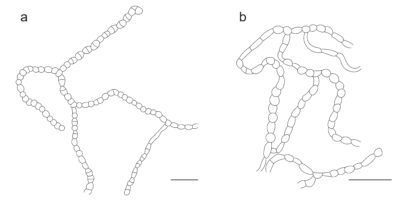Fungalpedia – Note 399, Arthrocatena
Arthrocatena Egidi & Selbmann
Citation when using this data: Tibpromma et al. 2024 (in prep.) – Fungalpedia, Rock-inhabiting fungi.
Index Fungorum, Facesoffungi, MycoBank, GenBank, Fig. 1
Classification: Incertae sedis, Capnodiales, Dothideomycetidae, Dothideomycetes, Pezizomycotina, Ascomycota, Fungi.
Arthrocatena was established by Egidi et al. (2014), with Arthrocatena tenebrosa designated as its type species. Utilizing Bayesian analyses of LSU, RPB2, ITS, and BT2 sequences, Egidi et al. (2014) demonstrated that Arthrocatena tenebrosa forms a distinct and highly supported basal clade within Teratosphaeriaceae. Phylogenetic analysis indicated that Arthrocatena tenebrosa is positioned on a single long branch, suggesting its affiliation with a separate species within its own clade. Introduced as a rock-inhabiting fungus in cold environments, Arthrocatena exhibits slow-growing, dark, velvety, and compact colonies. Its hyphae are torulose to dark brown, branched, and develop into longitudinal and oblique septa. These hyphae produced arthroconidia through disarticulation. The conidia of Arthrocatena are dark brown, thick-walled, and sometimes exhibit a median septum (Egidi et al. 2014). However, the sexual morph of Arthrocatena remains unknown. Initially, the generic name Arthrocatena, as introduced by Egidi et al. (2014), was considered invalid under Article 40.7 (Shenzhen) of the nomenclatural rules. Crous et al. (2019) later rectified this by publishing Arthrocatena as a validly established name. Wijayawardene et al. (2022) classified the genus Arthrocatena within the Mycosphaerellales genus incertae sedis, indicating its uncertain placement within this order. Currently, Arthrocatena is a monotypic genus, with no additional species introduced since its establishment, and thus remains monotypic.
Type species: Arthrocatena tenebrio Egidi & L. Selbmann
Other accepted species: Species Fungorum – search Arthrocatena
Figure 1 – Arthrocatena tenebrosa. a, b Thick-walled conidia resulting from arthric conidiogenesis. Scale bars: a, b = 10 μm. Redrawn from Egidi et al. (2014).
References
Entry by
Wanasinghe DN, Center for Mountain Futures, Kunming Institute of Botany, Chinese Academy of Sciences, Honghe 654400, China.
(Edited by Saowaluck Tibpromma, Samaneh Chaharmiri-Dokhaharani, & Achala R. Rathnayaka)
Published online 26 November 2024
